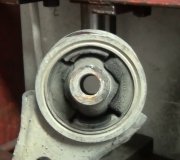The pressures pertain to the temperature when you're driving the car. In other words, you wouldn't set the pressure today, then drive the car tomorrow when it's much different. The pressures refer to when the tires are cold. Those pressures are expected to increase as the tires heat up.
There are two different schools of thought on what is the proper pressure. Some people will tell you to go strictly by the label on the car, usually by the back of the driver's door opening. I was taught at Chrysler classes and suspension and alignment classes put on by Carquest and NAPA to look at the maximum pressures listed on the sidewalls of the tires. New car tires are rated at either 35 psi or 44 psi maximum. The 44 pound tires have softer sidewalls. Both tires can support the same maximum weight at their different maximum pressures. That means a 35 psi tire might need 30 pounds to support the front of your car, but a 44 psi tire needs the same percentage of its maximum rating to hold the same weight, or about 38 pounds. Those numbers are just an example, but I picked them because I did a lot of new vehicle preps on Chryslers and checking tire pressures was one of the things we were required to do. The cars that came with 44 psi tires had very close to 38 psi from the factory but the stickers called for 30 psi.
There's a very legitimate reason they can't put 38 psi on the door stickers. They don't know where you're going to buy your replacement tires from or what their maximum pressure will be. If they listed the ideal 38 psi, 35 pound tires would be over-inflated. The door sticker is a guide but it does not cover every tire that might be installed on the car.
Keep in mind some people will tell you to go strictly by the sticker but you'll find different pressures listed in the owner's manual. They also make reference to "or tire manufacturer's recommendation".
After aligning cars for 24 years, nine at the dealership, I found the best results from setting 35 psi tires to 35 psi, and 44 psi tires to 40 psi. Never had a single complaint about harsh ride and even solved one complaint of hard steering while driving by increasing his pressures from 30 to 40 psi.
Your pressures will increase one or two pounds when the outside temperature increases by ten degrees. Most tires leak a little so you'll typically be adding air, not letting some out. The temperature can change more than 40 degrees from morning to afternoon, so obviously you can expect your tire pressures to change accordingly. That is factored in when they design the tire and any expected pressure increase will be well within the tire's safety margin.
If you want to go by the tire's maximum rating, the numbers are on the sidewall very close to the edge of the wheel. They are very small so you might need a magnifying glass to read them.
Friday, June 10th, 2011 AT 7:16 AM


